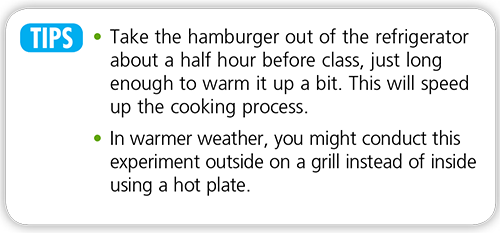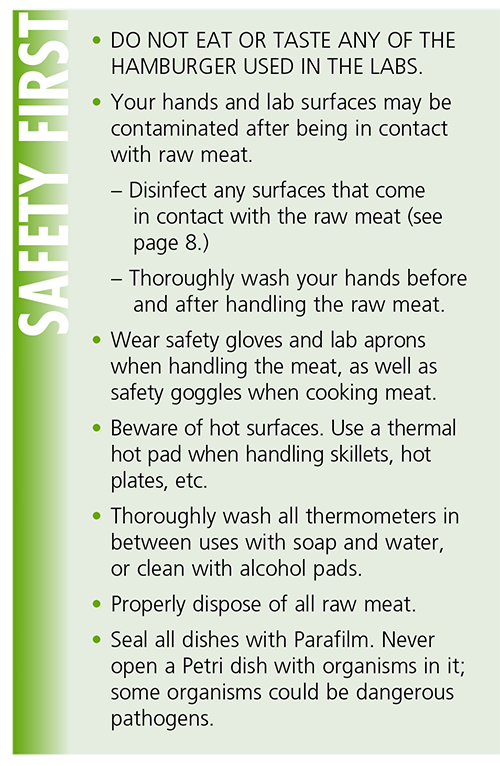Cooking Right: The Science of Cooking a Hamburger (Grades 6-8)
The teacher will demonstrate cooking hamburgers to different temperatures. Students will analyze Petri dishes inoculated with hamburger and observe the amount of bacteria at each temperature. They will also learn that cooking hamburgers to the recommended temperature of 160° F (71° C) will kill pathogenic bacteria. Hamburger is used for this cooking lab because it’s a food that students are familiar with and may be cooking at home.

Background
Lesson Activities
Recommended Companion Resources
Credits
Author
Food and Drug Association (FDA) and National Science Teaching Association (NSTA)
Acknowledgements
The Science and Our Food Supply Curriculum was brought to you by the Food and Drug Administration Center for Food Safety and Applied Nutrition and the National Science Teaching Association.
- FDA Education Team Leader Food Safety Initiative: Marjorie L. Davidson
- FDA Science and Our Food Supply Project Director: Louise H. Dickerson
- FDA/NSTA Associate Executive Director and Science and Our Food Supply Program Director: Christina Gorski
- FDA/NSTA Science and Our Food Supply Program Assistant: Jill Heywood
Standards
Texas Content Area Standards
-
Principles of Agriculture, Food, and Natural Resources: 130.2.c.1
The student demonstrates professional standards/employability skills as required by business and industry. The student is expected to:
- Principles of Agriculture, Food, and Natural Resources: 130.2.c.1.A: identify career development, education, and entrepreneurship opportunities in the field of agriculture, food, and natural resources.
- Principles of Agriculture, Food, and Natural Resources: 130.2.c.1.B: apply competencies related to resources, information, interpersonal skills, problem solving, critical thinking, and systems of operation in agriculture, food, and natural resources.
- Principles of Agriculture, Food, and Natural Resources: 130.2.c.1.C: demonstrate knowledge of personal and occupational safety, environmental regulations, and first-aid policy in the workplace.
- Principles of Agriculture, Food, and Natural Resources: 130.2.c.1.E: identify careers in agriculture, food, and natural resources with required aptitudes in science, technology, engineering, mathematics, language arts, and social studies.
-
Principles of Agriculture, Food, and Natural Resources: 130.2.c.4
The student explains the historical, current, and future significance of the agriculture, food, and natural resources industry. The student is expected to:
- Principles of Agriculture, Food, and Natural Resources: 130.2.c.4.B: analyze the scope of agriculture, food, and natural resources and its effect upon society.
-
Principles of Agriculture, Food, and Natural Resources: 130.2.c.6
The student demonstrates appropriate personal and communication skills. The student is expected to:
- Principles of Agriculture, Food, and Natural Resources: 130.2.c.6.A: demonstrate written and oral communication skills appropriate for formal and informal situations such as prepared and extemporaneous presentations.
- Principles of Agriculture, Food, and Natural Resources: 130.2.c.6.B: demonstrate effective listening skills appropriate for formal and informal situations.
-
Principles of Agriculture, Food, and Natural Resources: 130.2.c.7
The student applies appropriate research methods to agriculture, food, and natural resources topics. The student is expected to:
- Principles of Agriculture, Food, and Natural Resources: 130.2.c.7.B: use a variety of resources for research and development.
- Principles of Agriculture, Food, and Natural Resources: 130.2.c.7.C: describe scientific methods of research.
- Principles of Agricultures, Food, and Natural Resources: 130.2.c.7.A: discuss major research and developments in the fields of agriculture, food, and natural resources.
-
Principles of Agriculture, Food, and Natural Resources: 130.2.c.13
The student describes the principles of food products and processing systems. The student is expected to:
- Principles of Agriculture, Food, and Natural Resources: 130.2.c.13.A: evaluate food products and processing systems.
- Principles of Agriculture, Food, and Natural Resources: 130.2.c.13.B: determine trends in world food production.
- Principles of Agriculture, Food, and Natural Resources: 130.2.c.13.C: discuss current issues in food production.
- Principles of Agriculture, Food, and Natural Resources: 130.2.c.13.D: use tools, equipment, and personal protective equipment common to food products and processing systems.
-
ELA: 7.110.23.b.5
Comprehension skills: listening, speaking, reading, writing, and thinking using multiple texts. The student uses metacognitive skills to both develop and deepen comprehension of increasingly complex texts.
- ELA: 7.110.23.b.5.H: synthesize information to create new understanding
-
Science: 6.112.26.b.1
Scientific and engineering practices. The student, for at least 40% of instructional time, asks questions, identifies problems, and plans and safely conducts classroom, laboratory, and field investigations to answer questions, explain phenomena, or design solutions using appropriate tools and models. The student is expected to:
- Science: 6.112.26.b.1.A: ask questions and define problems based on observations or information from text, phenomena, models, or investigations
- Science: 6.112.26.b.1.B: use scientific practices to plan and conduct descriptive, comparative, and experimental investigations and use engineering practices to design solutions to problems
- Science: 6.112.26.b.1.E: collect quantitative data using the International System of Units (SI) and qualitative data as evidence;
- Science: 6.112.26.b.1.F: construct appropriate tables, graphs, maps, and charts using repeated trials and means to organize data;
-
Science: 6.112.26.b.3
Scientific and engineering practices. The student develops evidence-based explanations and communicates findings, conclusions, and proposed solutions. The student is expected to:
- Science: 6.112.26.b.3.A: develop explanations and propose solutions supported by data and models and consistent with scientific ideas, principles, and theories;
- Science: 6.112.26.b.3.B: communicate explanations and solutions individually and collaboratively in a variety of settings and formats; and
-
Science: 6.112.26.b.5
Recurring themes and concepts. The student understands that recurring themes and concepts provide a framework for making connections across disciplines. The student is expected to:
- Science: 6.112.26.b.5.A: identify and apply patterns to understand and connect scientific phenomena or to design solutions;
-
Science: 6.112.26.b.12
Organisms and environments. The student knows that interdependence occurs between living systems and the environment. The student is expected to:
- Science: 6.112.26.b.12.B: describe and give examples of predatory, competitive, and symbiotic relationships between organisms, including mutualism, parasitism, and commensalism;
-
Science: 6.112.26.b.13
Organisms and environments. The student knows that organisms have an organizational structure and variations can influence survival of populations. The student is expected to:
- Science: 6.112.26.b.13.A: describe the historical development of cell theory and explain how organisms are composed of one or more cells, which come from pre-existing cells and are the basic unit of structure and function;
- Science: 6.112.26.b.13.B: identify and compare the basic characteristics of organisms, including prokaryotic and eukaryotic, unicellular and multicellular, and autotrophic and heterotrophic; and
- Science: 6.112.26.b.13.C: describe how variations within a population can be an advantage or disadvantage to the survival of a population as environments change
-
Science: 7.112.27.b.1
Scientific and engineering practices. The student, for at least 40% of instructional time, asks questions, identifies problems, and plans and safely conducts classroom, laboratory, and field investigations to answer questions, explain phenomena, or design solutions using appropriate tools and models. The student is expected to:
- Science: 7.112.27.b.1.A: ask questions and define problems based on observations or information from text, phenomena, models, or investigations;
- Science: 7.112.27.b.1.B: use scientific practices to plan and conduct descriptive, comparative, and experimental investigations and use engineering practices to design solutions to problems;
- Science: 7.112.27.b.1.E: collect quantitative data using the International System of Units (SI) and qualitative data as evidence;
- Science: 7.112.27.b.1.F: construct appropriate tables, graphs, maps, and charts using repeated trials and means to organize data
-
Science: 7.112.27.b.3
Scientific and engineering practices. The student develops evidence-based explanations and communicates findings, conclusions, and proposed solutions. The student is expected to:
- Science: 7.112.27.b.3.A: develop explanations and propose solutions supported by data and models and consistent with scientific ideas, principles, and theories;
- Science: 7.112.27.b.3.B: communicate explanations and solutions individually and collaboratively in a variety of settings and formats; and
-
Science: 7.112.27.b.5
Recurring themes and concepts. The student understands that recurring themes and concepts provide a framework for making connections across disciplines. The student is expected to:
- Science: 7.112.27.b.5.A: identify and apply patterns to understand and connect scientific phenomena or to design solutions;
-
Science: 7.112.27.b.12
Organisms and environments. The student understands that ecosystems are dependent upon the cycling of matter and the flow of energy. The student is expected to:
- Science: 7.112.27.b.12.B: describe how ecosystems are sustained by the continuous flow of energy and the recycling of matter and nutrients within the biosphere.
-
Science: 7.112.27.b.14
Organisms and environments. The student knows how the taxonomic system is used to describe relationships between organisms. The student is expected to:
- Science: 7.112.27.b.14.B: describe the characteristics of the recognized kingdoms and their importance in ecosystems such as bacteria aiding digestion or fungi decomposing organic matter.
-
Science: 8.112.28.b.1
Scientific and engineering practices. The student, for at least 40% of instructional time, asks questions, identifies problems, and plans and safely conducts classroom, laboratory, and field investigations to answer questions, explain phenomena, or design solutions using appropriate tools and models. The student is expected to:
- Science: 8.112.28.b.1.A: ask questions and define problems based on observations or information from text, phenomena, models, or investigations;
- Science: 8.112.28.b.1.B: use scientific practices to plan and conduct descriptive, comparative, and experimental investigations and use engineering practices to design solutions to problems;
- Science: 8.112.28.b.1.E: collect quantitative data using the International System of Units (SI) and qualitative data as evidence;
- Science: 8.112.28.b.1.F: construct appropriate tables, graphs, maps, and charts using repeated trials and means to organize data;
-
Science: 8.112.28.b.3
Scientific and engineering practices. The student develops evidence-based explanations and communicates findings, conclusions, and proposed solutions. The student is expected to:
- Science: 8.112.28.b.3.A: develop explanations and propose solutions supported by data and models and consistent with scientific ideas, principles, and theories;
- Science: 8.112.28.b.3.B: communicate explanations and solutions individually and collaboratively in a variety of settings and formats; and
-
Science: 8.112.28.b.5
Recurring themes and concepts. The student understands that recurring themes and concepts provide a framework for making connections across disciplines. The student is expected to:
- Science: 8.112.28.b.5.A: identify and apply patterns to understand and connect scientific phenomena or to design solutions;
-
Science: 8.112.28.b.11
Earth and space. The student knows that natural events and human activity can impact global climate. The student is expected to:
- Science: 8.112.28.b.11.C: describe the carbon cycle.
-
Science: 8.112.28.b.13
Organisms and environments. The student knows how cell functions support the health of an organism and how adaptation and variation relate to survival. The student is expected to:
- Science: 8.112.28.b.13.B: describe the function of genes within chromosomes in determining inherited traits of offspring; and
- Science: 8.112.28.b.13.C: describe how variations of traits within a population lead to structural, behavioral, and physiological adaptations that influence the likelihood of survival and reproductive success of a species over generations.
-
ELA: 6.110.22.b.5
Comprehension skills: listening, speaking, reading, writing, and thinking using multiple texts. The student uses metacognitive skills to both develop and deepen comprehension of increasingly complex texts. The student is expected to:
- ELA: 6.110.22.b.5.H: synthesize information to create new understanding
-
ELA: 6.110.22.b.6
Response skills: listening, speaking, reading, writing, and thinking using multiple texts. The student responds to an increasingly challenging variety of sources that are read, heard, or viewed. The student is expected to:
- ELA: 6.110.22.b.6.F: respond using newly acquired vocabulary as appropriate
-
ELA: 8.110.24.b.5
Comprehension skills: listening, speaking, reading, writing, and thinking using multiple texts. The student uses metacognitive skills to both develop and deepen comprehension of increasingly complex texts. The student is expected to:
- ELA: 8.110.24.b.5.H: synthesize information to create new understanding
-
ELA: 8.110.24.b.6
Response skills: listening, speaking, reading, writing, and thinking using multiple texts. The student responds to an increasingly challenging variety of sources that are read, heard, or viewed. The student is expected to:
- ELA: 8.110.24.b.6.F: respond using newly acquired vocabulary as appropriate
-
Math: 6.111.26.b.1
Mathematical process standards. The student uses mathematical processes to acquire and demonstrate mathematical understanding. The student is expected to:
- Math: 6.111.26.b.1.A: apply mathematics to problems arising in everyday life, society, and the workplace
-
Math: 7.111.27.b.1
Mathematical process standards. The student uses mathematical processes to acquire and demonstrate mathematical understanding. The student is expected to:
- Math: 7.111.27.b.1.A: apply mathematics to problems arising in everyday life, society, and the workplace
-
Math: 8.111.28.b.1
Mathematical process standards. The student uses mathematical processes to acquire and demonstrate mathematical understanding. The student is expected to:
- Math: 8.111.28.b.1.A: apply mathematics to problems arising in everyday life, society, and the workplace

 It’s particularly important to cook ground meats such as hamburger thoroughly, because there’s a greater chance for bacterial contamination with ground meat than with whole cuts. The bacteria start out on the outside of the meat. When the meat is ground, any bacteria that were originally on the outside can be distributed throughout the hamburger. In addition, when making patties, harmful bacteria from hands, utensils, and surfaces can be transferred to the inside of the hamburger patty. It’s important, therefore, to make sure that the internal temperature of the hamburger has reached a safe internal temperature (160° F [71° C]) to kill foodborne pathogens that may be present.
It’s particularly important to cook ground meats such as hamburger thoroughly, because there’s a greater chance for bacterial contamination with ground meat than with whole cuts. The bacteria start out on the outside of the meat. When the meat is ground, any bacteria that were originally on the outside can be distributed throughout the hamburger. In addition, when making patties, harmful bacteria from hands, utensils, and surfaces can be transferred to the inside of the hamburger patty. It’s important, therefore, to make sure that the internal temperature of the hamburger has reached a safe internal temperature (160° F [71° C]) to kill foodborne pathogens that may be present.